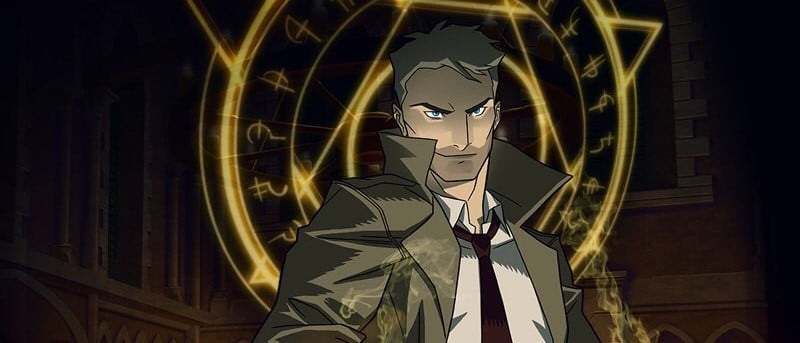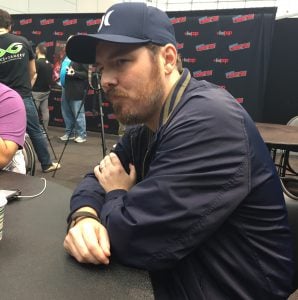
“What should this look like?” As art director, it’s Phil Bourassa’s job to answer that very question. When you’re working on a film like ‘Constantine: City of Demons’, sometimes the answer is fairly clear cut. After all, Constantine himself has a fairly well-established look and Bourassa wasn’t hired to reinvent the wheel. But that’s not to say there are no realms in which the art department is able to cut loose. Quite the contrary, in fact. Speaking ahead of the film’s New York Comic Con premiere, Bourassa addressed these questions of creative freedom, the enduring popularity of supernatural characters, and more.
What kind of challenges are there in designing the characters for a series or a movie that’s based on something with a well-defined look?
With certain characters, what’s in the comic is perfect. It’s not something that needs interpretation to be put in a different medium. Like with ‘Constantine’, with John, in particular, that’s an archetypal look that looks like it fits in any… Take it from the time period it was created in the eighties or it’s contemporary now. Or take it back to the forties or fifties. It’s a disheveled, you know, charming rogue in a trenchcoat who smokes and drinks. So it’s not something that I felt I needed to put my own particular spin on. Because I don’t feel like that’s always my job. Sometimes it’s just literally interpreting or translating the work of the people who created it and putting it in the medium that I work in. Now, certain things are gonna be idiosyncratic to my style because it’s just my natural speaking voice, on a certain level. But for that character, across all mediums with a few exceptions – someone brought up the Keanu Reeves version [laughs] – he’s not broke, he’s perfect so you can just drop him right in. A lot of times my job is “This character hasn’t been dusted off in thirty years, it needs to be punched up,” or “It would be fine if we were doing an homage to that era in the comics, but we’re doing a more modern narrative.” It’s all contextual, and in those cases, I do take that responsibility seriously. “Let me update this without breaking it.” It should still feel like the character. And that’s always the responsibility you should have because they’re not my characters. I’m just passing through, so I want to make sure I leave it in working order for the next people that work on this stuff.
Where did you have the most creative freedom and the least?
Well, the most creative freedom across the board on most of these projects is with the villains because they lend themselves to more interpretation. And demonic characters and monstrous characters, in particular, can be anything, so the sky’s the limit. There’s no wrong way to do it, it’s very interpretive. So you can just have a lot of fun with that. And then on the flip side, it is the characters that should not be trifled with, and I consider John one of those characters.
 Where there any lessons that you took from ‘Justice League Dark’ and applied to this?
Where there any lessons that you took from ‘Justice League Dark’ and applied to this?
We’re like an assembly line, and I think I learn something from every project. But when and where that gets applied may not be the very next iteration of that thing. And it also depends on our other collaborators. Like we were working with a certain group of animators on ‘Dark’ and we had different animators on this, so you try to play to the strengths of your team. But that’s across the board. I can’t think of anything from ‘Justice League Dark’ particularly. But definitely, the groundwork was laid there for the demonic look of the characters. For this movie, there was a lot of great work done in the effects department, which I think is super important. I also think the color pallet is really strong and those types of things can affect the look. But we’re constantly moving, so it’s difficult to say “I’ll do that differently on this the next time it comes around.”
One of the big things about ‘City of Demons’ is that it’s R-rated. How do you take that into consideration?
For instance, when we got the green light for ‘Justice League Dark’, I just inherently would start drawing John with a cigarette for the mood pieces and stuff like that. And they gave us a PG-13. We didn’t know we would eventually get an R, so they made me take the cigarettes out. And when we got the R, we were like “Oh, we could’ve had him smoking and doing all this stuff the whole time!” But the thing about going from a PG-13 to an R is I don’t think it really affects visual interpretation that much. I think what it affects is representations or references to sex or drugs. Or just add more blood or decapitations or whatever! Suddenly it’s an R! It’s not like it’s a really sophisticated gauge, and it doesn’t really affect the way I think of art direction. and style. So for me, it’s not a huge thing. You can go as far as you want with things like demons. You just can’t do explicit things with sex or drugs or whatever.
In terms of your approach to these characters and the world they live in, was it influenced by a particular run of ‘Hellblazer’ comics or was it more about the archetypes?
I think it’s more archetypal. It’s the themes and the tone of that world. I didn’t read a lot of ‘Hellblazer’ comics, although I feel like I should get into them because they just seem really cool. But I understand the tone of it and like I said, it’s this sort of gothic, noir-ish occult stuff. Which is really cool and it’s not your typical capes and tights fare. And I love doing that stuff too, but this is a different genre almost. So that’s what influenced it, looking at stuff that’s different than your typical superhero fare, more noir-ish stuff. You’re always trying to find the best framework, so you find things that are done in that style that’s evocative of those things. ‘Hellblazer’ was always political and supernatural with all this stuff woven in, so you try to infuse the work with that.
You’ve mentioned respecting the way in which characters were originally created. So being an artist, who are some of the people that have influenced you?
I can’t really say that I was influenced on the look of this by any particular artsts, because I don’t look at artists for that anymore. But when I was a kid, I fell in love with artists that were in comics, Marvel artists like John Buscema, Gil Kane, Alex Tot, Neal Adams. Just a lot of different American comic book artists. And then I got into Japanese comic book art, Toriyama and Shiro and guys like that. But ultimately as an artist, you have your influences, but by the time you’re mature, you’re not really looking for them. So I could get an idea from somewhere, but it could come from anywhere. It could come from music, or a film, or a novel. A writer could write some prose that’s really evocative of an image.
What do you think the increasing popularity of supernatural characters like Constantine and Doctor Strange over the past few years?
I think supernatural stuff has always been kind of cool. Even if it wasn’t from the comic book medium, you’ve always had stories that dealt with the macabre or the horrific. There’s always been iterations of that stuff. So I think that now that the comic book medium is being mined – some would say exploited. Sometimes it’s more underground, but there’s always something. I mean, everybody’s read ‘Dracula’.
‘Constantine: City of Demons’ stars Matt Ryan, Damian O’Hare, and Rachel Kimsey. The film is available now on blu-ray, DVD, and digital platforms.
